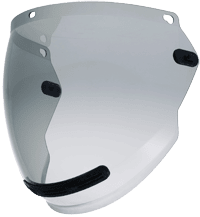In industrial work environments, safeguarding one’s vision is critical to overall worker safety. ANSI Z87.1, the national safety standard for personal eye and face protection devices, delineates crucial distinctions between primary and secondary eye protection. Understanding the difference between the two is pivotal for both workers and safety professionals to ensure comprehensive eye safety protocols. Let’s delve into the specifics.
Primary Eye Protection
Primary eye protection, as per ANSI Z87.1, refers to protective eyewear designed to shield against anticipated hazards, offering frontline defense. This includes safety glasses and goggles engineered to withstand high-velocity impacts, flying debris, and chemical splashes commonly encountered in industrial environments. These protective devices adhere to rigorous standards, ensuring robust resistance against potential threats.
Examples of Primary Eye Protection:
- Safety Glasses: Constructed from durable materials such as polycarbonate, safety glasses feature impact-resistant lenses and sturdy frames. They are ideal for tasks involving moderate risks, such as machining, woodworking, or metalworking.
- Safety Goggles: Offering a sealed fit around the eyes, safety goggles provide superior protection against airborne particles, liquids, and vapors. They are suitable for environments where chemical exposure or fine particulates pose hazards, such as laboratory work or chemical handling.
Secondary Eye Protection
Secondary eye protection serves as a supplementary layer of defense, worn over primary eyewear to enhance safety in specific conditions or tasks. While primary eye protection addresses foreseeable risks, secondary protection often mitigates unforeseen or elevated hazards, enhancing overall safety measures. That said, ANSI Z87.1 dictates that primary eye protection is still required when wearing secondary eye protection. For example, workers who wear face shields while doing their job must also wear primary eye protection like safety glasses.
Examples of Secondary Eye Protection:
- Face Shields: Designed to cover the entire face, face shields offer extensive protection against various hazards, including electric arc flash, impact, heat, chemical splashes, and molten metal splatter. They are indispensable in environments where the risk of severe facial injuries is high, such as welding, metal casting, or grinding operations.
- Welding Helmets: Specifically engineered for welding applications, welding helmets provide full-face coverage, with many being equipped with auto-darkening lenses. These helmets shield against the intense light, sparks, and infrared radiation emitted during welding processes, ensuring optimal safety for welders.
Distinguishing Between Primary and Secondary Eye Protection
While both primary and secondary eye protection are integral components of industrial safety, discerning their roles is essential for effective risk management. Primary eye protection addresses routine hazards encountered during everyday tasks, offering direct defense against anticipated risks. On the other hand, secondary eye protection provides additional safeguards against elevated hazards, thereby bolstering overall safety protocols.
Adherence to ANSI Z87.1 mandates a comprehensive approach to eye protection in industrial settings. By understanding the difference between primary and secondary eye protection, and implementing appropriate measures, industrial workers and safety professionals can fortify workplace safety, safeguarding the vision and well-being of their workforce amidst the rigors of industrial operations.
To learn more about primary vs. secondary eye protection as defined by ANSI Z87.1, please contact us today.




